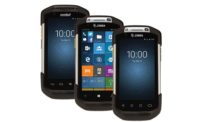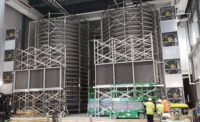Cold-chain management goes high-tech
New technology maintains and tracks temperatures throughout the supply chain

courtesy of CAS DataLoggers

courtesy of CAS DataLoggers

courtesy of DeltaTrak

courtesy of DeltaTrak

courtesy of Omega Engineering Inc.

courtesy of WOW Logistics Co.






Efficient cold-chain management is vital to bakers and snack producers, as consumers demand products that are fresh and government regulations require food producers to ensure food safety. Product traceability is another factor impacting this area.
Fortunately, plenty of new technology is now available to help bakers and snack producers maintain and track temperatures throughout their supply chains.
Poised for growth
“Bringing any food product from a frozen state to chilled temperatures must be done with careful attention to food safety,” says Corey Rosenbusch, president, Global Cold Chain Alliance (GCCA), Alexandria, VA. “The cold-chain industry has developed technologies and procedures to meet this demand and to ensure that food safety is the highest priority in tempering activities.”
From the baker’s perspective, growth of cold and frozen storage has been steady, but appears poised for significant growth in the next few years, notes Robb MacKie, president and CEO, American Bakers Association (ABA), Washington, DC. “Along with significant food-safety benefits, there are greater potential benefits in terms of extending the shelf life of bakery products without a reduction in product quality, nutrition and appearance,” he says. “This, in turn, could lead to a rethinking of a number of current industry processes and ultimately lead to revamping production schedules, allowing for greater workforce flexibility. The American Bakers Association is excited that our new strategic partnership with GCCA will allow for a full exploration of those potential opportunities.”
While cold storage is a vital component of food production, more regulations are being imposed on tracking procedures and quality standards related to cold-storage management. In addition, two major trends are converging in this area: the transition away from synthetic refrigerants due to environmental concerns and the development of low charge ammonia refrigeration systems.
“Looking at the big picture, the convergence of regulations is one of the drivers toward the development of new technologies for refrigeration systems across the cold chain,” Rosenbusch says. Concerns about the environmental impacts of synthetic refrigerants are generating new interest in natural refrigerants, such as ammonia. At the same time, regulations are being considered that would add to the compliance burden for larger ammonia refrigeration systems.
FDA recently published its final rule on Sanitary Transportation of Human and Animal Food, a part of the Food Safety Modernization Act (FSMA). The rule establishes new guidelines for how shippers, carriers and receivers must work together to maintain food safety throughout the supply chain. FSMA regulations also highlight other aspects of food safety, ranging from temperature-monitoring systems to methods for food traceability.
The Preventive Controls for Human Food rule is a major theme of FSMA, Rosenbusch adds. Finalized in September 2015, it establishes a detailed framework by which facilities must develop and implement plans to prevent food-safety problems. “Temperature management will be the critical preventive control factor, and this has long been a core competency of cold-storage companies,” he notes.
Because of traceability changes due to FSMA implementation, cold-chain storage facilities and cold-chain transportation providers must now ensure that their systems are providing required data and information, according to Eric Pfeiffer, senior director, supply-chain integration, HAVI Global Solutions, Downers Grove, IL. This will require system upgrades, or implementations, that enable product tracking not only at the storage location, but one step back and one step forward in the supply chain. “The cost of these upgrades and implementations can be steep,” Pfeiffer explains, “but having greater visibility of the product in storage and in transit—and the associated use-through dates of those products—provides an opportunity to better manage freshness.”
Going wireless
Cold-storage equipment manufacturers offer technology to maintain and track temperatures for finished food products from the point of storage in a bakery or snack facility through distribution to the end customer. Producers can invest in systems integrated with refrigerators and freezers, standalone temperature controls and software to track temperatures throughout storage and distribution.
Cold-storage facilities, meanwhile, are moving toward wireless systems that can report temperature and humidity in real-time and send alerts when out-of-range conditions occur, according to Frederick Wu, president and CEO, DeltaTrak, Pleasanton, CA. “This allows quality-control and plant managers to see current readings at any time,” he explains. “Alerts are sent out as soon as a violation occurs, so staff can take immediate corrective action to prevent damage to products.”
Stewart Thompson, marketing specialist, CAS DataLoggers, Chesterland, OH, says the cold-chain market is moving toward adoption of wireless temperature-monitoring systems, such as data loggers. “Many incorporate a wireless gateway to send the information to a network PC or to email accounts for alarm notification,” he explains. “This can help businesses prevent disastrous losses due to food spoilage.”
These systems also are used to monitor perishable products in transit. For example, a temperature data logger can be used to monitor the internal temperature of a refrigerated truck’s frozen compartments.
“We are seeing increased interest in automated and real-time temperature monitoring,” says Amy Childress, vice president, marketing and business development, PakSense, Boise, ID. “In the past, a temperature logger device would be placed on or near a perishable item. When it was time to take a look at the information, the user had to retrieve the logger, put it into a reader device and download it with software.” Today, in-transit and facility temperature monitoring can be done with wireless technologies that automatically deliver data to smartphones and user-accessible databases via wireless and cellular transmissions.
Beyond their contributions to food safety and regulatory standards, such systems also increase efficiencies. “Many food processors are interested in systems that monitor all segments of their supply chain,” says Childress. “This includes in-transit segments such as the supplier to distribution center, facility monitoring at the distribution center, distribution center to retail location and facility monitoring at the retail location. Food processors want to source an end-to-end system from one supplier.”
Wireless data collection is also useful for temperature profiling in storage units, storage areas and trucks en route to vendors. “This helps to identify areas of poor coverage where HVAC systems leave warmer or colder gaps in the storage environment,” adds Thompson. “Remediating these gaps often leads to improved product storage and quality. CAS distributes wireless temperature data loggers to help in this area.”
Cold-chain innovations
PakSense recently released several automated and wireless cold-chain solutions that use cellular readers to transmit data. All use cellular connectivity as their conduit to a cloud database. The solutions are modular and can be combined to create continuous cold-chain monitoring.
DeltaTrak’s FlashTrak Telematics Cold Storage Solution is a wireless system that provides real-time, continuous monitoring and recording in facilities where temperature-sensitive products are stored, such as warehouses, distribution centers, walk-in coolers, and processing, packing and staging areas. FlashTrak data loggers monitor temperature and humidity, and transmit the data to a facility control system, which uploads the information to a central database via cellular network or Wi-Fi.
The OM-21 data logger from Omega Engineering Inc., Stamford, CT, is used in cold-chain applications to monitor food and other temperature-sensitive products during transport. The data logger is user-programmable. No special software or driver is required for the setup or download of data. On completion of data logging, the system generates a PDF report, which contains a data summary, graph and tabular results, says Tony Corvini, applications engineer for the company.
WOW Logistics Co., Appleton, WI, has developed a new cooler monitoring system that allows online control of temperature, custom-generated temperature reports and low/high temperature notification alarm—with real-time corrective action—as well as mobile access to software, according to Josh Rodman, vice president of operations for the company.
Future developments
With all the high-tech cold-chain management solutions now available to bakers and snack producers, what product developments and improvements could still be on the horizon?
Many see the market moving toward Wi-Fi connectivity as part of this developing picture. “In the ideal setup, temperature sensors will constantly communicate with each other and with facilities managers’ email addresses,” says Thompson. “Sensor feedback also will become tightly integrated with control capability—for example, humidity sensor data with HVAC control.”
New approaches toward cold storage will also likely play a role. “The major advancements I see on the horizon are in storage systems,” Rodman notes. “We will continue to see new, more-efficient storage systems that will allow food processors to get better storage density in cold storage facilities.”
Looking for a reprint of this article?
From high-res PDFs to custom plaques, order your copy today!












